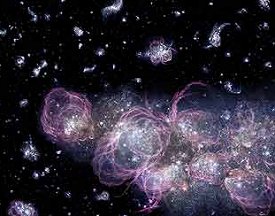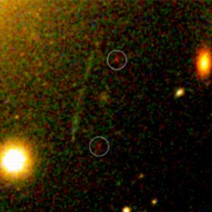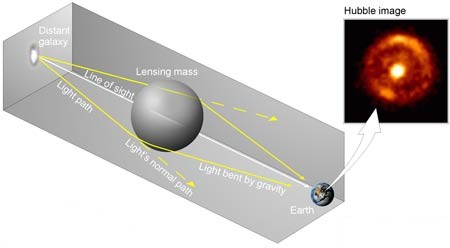|
By peering through a giant cosmic lens, scientists
have found some of the first-born stars in our Universe.
by Patrick L. Barry and Dr
Tony Phillips
Imagine being able to see our Universe
14 billion years ago when it was just a baby. If we had a time machine,
we could go back and watch how its infant features emerged after the
Big Bang.
There are many questions about that early time: Which came first,
stars or galaxies? Did stars appear one at a time, or in massive
flurries of simultaneous creation? Scientists have theories, but
how wonderful it would be to actually look back in time and see
for certain.
Well believe it or not, time machines do exist - they're called
telescopes. Astronomers who peer through them see stars and galaxies
not as they are now, but as they appeared when the starlight began
its journey. Through telescopes, astronomers can "travel" billions
of years into the past.
Astronomer Richard Ellis of the California Institute
of Technology recently used NASA's Hubble Space Telescope to travel
backwards nearly to the time of the Big Bang itself. He and his
colleagues went in search of newborn stars - the first ones to
appear in our Universe.
Ellis explains: "At some point a billion or
so years after the Big Bang, gravitational attraction caused the
gas that filled the Universe to collapse and form the first stars.
Searching for signs of those stars, which we call First Light, is
one of the most interesting challenges in modern astronomy."

more
This fanciful
image by artist Adolph Schaller depicts the riotous formation
of the very first stars in the Universe.
|
The search is daunting because such
stars lie more than 10 billion light-years
from Earth. They're very faint. Even powerful instruments like Hubble
have trouble detecting them.
So, Ellis and colleagues did what many of us
do when we're straining to see something:. They used a magnifying
glass. They pointed the Hubble Space Telescope and, later, the Keck
Telescope in Hawaii at a "gravitational lens" - a giant cosmic
magnifier formed from a group of galaxies 2 to 3 billion light-years
away.
Peering through the unusual lens, they observed
a faint cloud of stars lying 13.4 billion light-years from Earth.
The cloud, like a very small galaxy, contained about a million stars.
For comparison, typical galaxies in the Universe today contain hundreds
of billions of stars. Ellis and his colleagues believe the diminutive
cloud is a building block of the full-sized galaxies that now populate
our Universe.
If the Universe is 14 billion years old, as
some models hold, then the star cloud existed less than one billion
years after the Big Bang - just when theorists think the first
stars probably formed. Indeed, the stars in the cloud appear to
be very young. Spectral evidence suggests that they are roughly
2 to 5 million years old, though Ellis cautions that this evidence
is still being debated among researchers. The Sun, for comparison
is about 4.8 billion years old.

Credit: the ESA, NASA, Richard Ellis (Caltech,
USA) and Jean-Paul Kneib (Observatoire Midi-Pyrenees, France).
A blow-up
of the boxed area in the Hubble image above. Circled are
the faint, twin images of the star cloud.
|
"We're seeing this cluster while it's switching
on," Ellis says. The stars in the cloud were among the first, perhaps,
to light up the heavens.
Without a boost from the gravitational lens, which brightened the
star cloud's light by approximately 30 times, neither the Keck 10-meter
telescope nor the Hubble Space Telescope would have detected these
distant, young stars, notes Ellis.
Such magnifying lenses are one of the odd realities of Einstein's
theory of general relativity: Einstein showed that mass creates
a local curvature in the geometry of space-time that can bend the
path of light. The strong curvature caused by the massive group
of galaxies Ellis used for this research was able to bend and focus
light rays from the star cloud far behind it, just like the lens
in a magnifying glass.
"By looking at particular regions of the sky where the light from
the very early Universe is highly magnified by a gravitational lens,
we get a helpful boost from nature in searching for these feeble
signals," Ellis adds.
More than 500 such gravitational lenses have been identified. But
to be useful in the search for First Light, a lens must be thoroughly
studied so that scientists know precisely how it bends light, in
the same way that knowing the shape of a funhouse mirror can tell
you how it reflects light. Currently there are about 10 such well-studied
lenses.
"Everybody wants to know, Was this a fluke?," remarks Ellis.
"If these are really the first stars in the Universe, then there
should be a huge number of them in the sky."

Image courtesy European Space Agency more
In this
example of a gravitational lens, light from a distant galaxy
forms a halo around the massive lensing object.
|
NASA's Next Generation Space Telescope
(NGST), scheduled for
launch in 2009, will reveal the answer. "The NGST will be able to
detect these objects without any help from gravitational lenses,"
Ellis says. "There'll be no question - we'll be able to count them
and figure out how old they are."
Meanwhile, astronomers will continue peering
through gravitational lenses, hoping to catch a glimpse of what
emerged after the Big Bang. It's worth a look. After all, strange
galaxies and riotous stars could be just the beginning ... of what
lies in the past.
NOTE: The opening
passages of this story ask Which came first, stars or galaxies?
Some readers may wonder how galaxies, which are made of stars, could
possibly precede the stars themselves. It sounds like a paradox,
but it's not. The first galaxies might have formed as great whirlpools
of gas from which stars condensed. Or perhaps the stars formed first,
and later gathered together as galaxies. It's an important question
for astronomers who study the evolution of our Universe.
|
